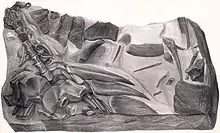1833 in paleontology
Paleontology or palaeontology is the study of prehistoric life forms on Earth through the examination of plant and animal fossils.[1] This includes the study of body fossils, tracks (ichnites), burrows, cast-off parts, fossilised feces (coprolites), palynomorphs and chemical residues. Because humans have encountered fossils for millennia, paleontology has a long history both before and after becoming formalized as a science. This article records significant discoveries and events related to paleontology that occurred or were published in the year 1833.
| |||
|---|---|---|---|
|
Dinosaurs
Newly named dinosaurs
| Taxon | Novelty | Status | Author(s) | Age | Unit | Location | Notes | Images |
|---|---|---|---|---|---|---|---|---|
|
Gen. nov. |
Probably a teleosaurid crocodyliform in addition to being "forgotten."[3] |
|||||||
|
Gen. et sp. nov. |
Valid |
Early Cretaceous, 140–136 million years ago[5] |
Tilgate Forest, Grinstead Clay Formation,[5] Westfalen[6] |
Hylaeosaurus was named in 1833 by Mantell for most of a skeleton including an isolated tail. This material was then later described in more detail by Mantell and Alexander Gordon Melville in an 1849 publication entitled Additional Observations on the Osteology of the Iguanodon and Hylaeosaurus.[7] |
| |||
Pterosaurs
New taxa
| Name | Novelty | Status | Author(s) | Age | Unit | Location | Notes | Images |
|---|---|---|---|---|---|---|---|---|
|
Gen. et sp. nov. |
Valid |
Late Jurassic, 155–150 million years ago |
A gnathosaurine ctenochasmatid. This is one of two species assigned to Gnathosaurus, the other being G. macrurus. Aurorazhdarcho is a potential junior synonym of Gnathosaurus subulatus.[9] Gnathosaurus as well as related genera such as Germanodactylus, Ctenochasma, and Pterodactylus all possessed large soft tissue crests. All four genera are from the Solnhofen Limestone, and share a common ancestor which, presumably, also had a crest.[8] |
| ||||
References
- Gini-Newman, Garfield; Graham, Elizabeth (2001). Echoes from the past: world history to the 16th century. Toronto: McGraw-Hill Ryerson Ltd. ISBN 9780070887398. OCLC 46769716.
- Saint-Hilaire, G.É-F. (1833). "Considérations sur les ossements fossiles, la plupart inconnus, trouvés et observés dans les bassins d'Auvergne". Revue Encyclopédique. 59: 76–95.
- Olshevsky, George. "Dinogeorge's Dinosaur Genera List". Retrieved 2008-08-07.
- Mantell, G.A. (1833). "Observations on the remains of the Iguanodon, and other fossil reptiles, of the strata of Tilgate Forest in Sussex". Proceedings of the Geological Society of London. 1: 410–411.
- Naish, D.; Martill, D.M. (2008). Dinosaurs of Great Britain and the role of the Geological Society of London in their discovery: Ornithischia. Journal of the Geological Society. 165. London. pp. 613–623.
- Sachs, S.; Hornung, J. J. (2013). Evans, David C (ed.). "Ankylosaur Remains from the Early Cretaceous (Valanginian) of Northwestern Germany". PLoS ONE. 8 (4): e60571. doi:10.1371/journal.pone.0060571. PMC 3616133. PMID 23560099.
- Mantell, G.A.; Melville, A.G. (1849). "Additional Observations on the Osteology of the Iguanodon and Hylaeosaurus". Philosophical Transactions of the Royal Society of London. 139: 271–305. doi:10.1098/rstl.1849.0015. JSTOR 108479.
- Bennett, C.S. (2002). "Soft Tissue Preservation of the Cranial Crest of the Pterosaur Germanodactylus from Solnhofen". Journal of Vertebrate Paleontology. 22 (1): 43–48. doi:10.1671/0272-4634(2002)022[0043:STPOTC]2.0.CO;2. JSTOR 4524192.
- Bennett, C.S. (2013). "New information on body size and cranial display structures of Pterodactylus antiquus, with a revision of the genus". Paläontologische Zeitschrift. 87 (2): 269–289. doi:10.1007/s12542-012-0159-8.


